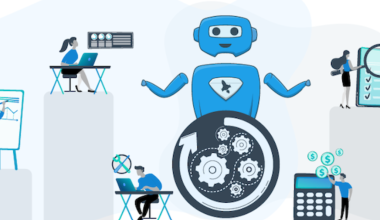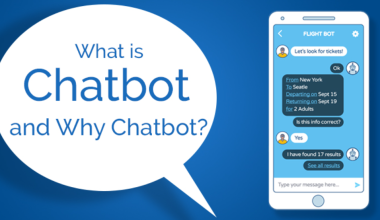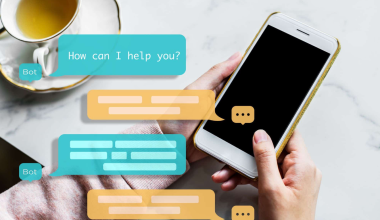In the fast-evolving technology landscape, chatbots are emerging as an indispensable tool that can revolutionize customer service, sales, and marketing. In this blog, we will learn how a chatbot can help your business and how many smart business people can benefit from it in this new world.
20 Benefits of Chatbot for Business and Customers
Chatbots are basically AI-powered virtual assistants that are capable of delivering personalized experiences, multilingual support, and self-service options, catering to the diverse and ever-increasing demands of modern customers. If you are new to it, here’s a complete guide about chatbots.
Let’s now look into all the benefits of Chatbots one by one:
1) 24/7 Customer Service
Customers today expect instant and accessible support, and bots excel at delivering this. With chatbots, businesses can provide round-the-clock assistance, that eliminates wait times. They are available even during peak hours when human agents may not be working. This is particularly valuable for international customers in different time zones.

These are always awake and ready to handle inquiries, ensuring that customers can get help at their convenience. Furthermore, they can manage a high volume of inquiries simultaneously.
You can check more about Chatbot’s benefits in customer service here and tips to improve it.
2) Personalized Experiences
The era of personalization is upon us! By integrating these virtual assistants with customer data and business systems, companies can offer highly personalized experiences.
Chatbots can modify the messages and replies according to the specific phase of the customer’s journey. This way, they can provide information and recommendations that align with individual preferences, behaviours, and demographics.
For instance, they can suggest products or services based on a customer’s past purchases or real-time behavioural data to adjust their recommendations, ensuring that interactions remain relevant.
3) Multilingual Support
For online businesses to go global, they need multilingual support, and this tool is well-suited to this task. At the start of a conversation, chatbots can ask customers for their preferred language or, through AI, automatically detect the language based on customer inputs. This facilitates communication in multiple languages through text, voice, or chat.
Additionally, multilingual bots can go beyond language translation; they can adapt to different cultural nuances and preferences, ensuring that customers from diverse backgrounds have a seamless and culturally sensitive experience.
4) Self-Service Options
Customers increasingly value the ability to resolve issues on their own and access information conveniently. Chatbots excel in providing self-service options, where can guide customers to resources like community forums, FAQ pages, and help centre articles.
As an additional benefit, these assistants learn from each interaction, continually improving the quality of their self-service capabilities. This means that over time, they become even more adept at assisting customers in completing tasks, finding information, and resolving issues independently.
This shift towards self-service options significantly reduces the workload on human agents and decreases customer frustration. You can learn more about Chatbot vs Live Chat to find which one suits your business the best.
5) Omnichannel Support
In today’s digital landscape, customers engage with brands through a variety of communication channels, from email and websites to messaging apps and social media. They expect their conversations to seamlessly transition between these platforms, picking up where they left off. However, many businesses struggle to offer this type of integrated experience.
Chatbots provide a solution by answering common questions across various channels and integrating with the company’s tech stack. Facilitating consistent interactions across different channels enhances customer satisfaction and loyalty.
6) Collect Customer Feedback
Feedback is essential for any business looking to improve its products and services. Chatbots can be programmed to actively seek feedback from customers at the end of interactions.
After resolving an issue or answering a question, the bot can send a single survey question within the chat, asking the customer to rate their satisfaction on a scale of one to five and provide any additional comments if they wish.
To encourage feedback participation, businesses can offer discount codes or special offers. You can also analyze conversation logs to identify recurring problems and areas where they excel. This data is invaluable for refining the overall customer experience.
7) Reduce Customer Requests
By handling repetitive inquiries, chatbots can effectively reduce potential tickets and workload on human agents. They are well-equipped to address general questions, provide self-service options, and assist customers in finding the answers they need. This reduction in routine customer requests is a significant efficiency gain for businesses.
8) Detect Customer Intent for Added Context
Advanced AI bots can understand customer intent and sentiment based on language and phrasing. Customer intent relates to understanding a customer’s specific question, while sentiment involves recognizing whether a customer’s message is positive, negative, or neutral.

They can accurately detect these details and pass them to human agents to provide critical contexts for interactions. Armed with this information, agents can personalize their responses and interactions, leading to more efficient issue resolution and a higher level of customer satisfaction.
Moreover, these insights can also be used to predict and prevent potential escalations, further enhancing the customer experience. There are many more ways AI can improve any business website.
9) Boost Customer Engagement
According to the Zendesk CX Trends Report, 64% of customers believe that bots can provide the same level of service as humans. However, this is only the tip of the iceberg. They can contribute to a richer and more engaging customer experience in various ways.
Chatbots can send proactive messages, such as order status updates, tracking numbers, or notifications regarding payment issues. These messages not only provide customers with critical information but also encourage ongoing interaction.
Bots can also send reminders, and appointment confirmations, and offer customized messaging aligned with the brand’s voice and tone.
Furthermore, they can provide a deep level of personalization by using various rich messaging types, including carousels, forms, emojis or gifs to make the interactions more fun.
10) Streamline Service with Routing and Triage
Chatbots can collect essential information from customers at the beginning and can ensure that the conversation is directed to the best-suited agent based on skills, availability, and issue priority. This seamless handoff from bots to human agents is invaluable in reducing resolution times and ensuring that customers receive prompt and effective support.
With the ability to collect and route data intelligently, they play a pivotal role in streamlining customer service, saving time for both customers and agents.
11) Boost Sales
Chatbots can serve as virtual sales assistants by collecting crucial information and qualifying leads. For example, they can inquire about a customer’s specific needs, helping to identify potential sales opportunities.
Additionally, they can actively engage with website visitors, guiding them through the decision-making process and answering questions to drive conversion. Nurturing prospects and potential customers, can reduce bounce rates and abandoned shopping carts. Their ability to automate cross-selling and upselling activities also proves invaluable in maximizing revenue.
12) Increase Lead Generation
Lead generation is a critical component of many businesses’ growth strategies. Chatbots can use customer data, machine learning, and natural language processing to engage in natural, conversational interactions that mimic human interactions.
Instead of directing a customer to a static form, the bot can create a dynamic conversational flow, capturing valuable customer data while providing a personalized experience.
The data collected includes insights into the pages a customer has visited, information about abandoned shopping carts, details about languages and geolocation, and preferences. This rich pool of data can be transmitted to the marketing team, empowering them to identify consumer trends, behaviours, and preferences for use in targeted marketing campaigns.
13) Enhance Conversational Commerce and Marketing
The emergence of conversational commerce has transformed the way businesses interact with customers, and chatbots have become integral to this shift. For instance, online retailers can deploy them to function as virtual assistants, offering instant support and answering product-related questions on demand.
A chatbot can provide proactive assistance regarding products in a customer’s shopping cart, nudging them toward completing a purchase. This approach transforms bots into active sales and marketing tools, seamlessly integrating them into the customer’s shopping journey. This personalized approach can create a richer shopping experience.
14) Streamline Checkout Process
The checkout process is a crucial stage in the customer journey. A chatbot can provide proactive outbound messages such as personalized offers, and can create upsell opportunities. For instance, they can offer discounts to entice customers to complete a purchase or send reminders to encourage customers to return to their abandoned shopping carts.
Furthermore, these can assist customers who may have additional questions about a product, encounter issues related to shipping costs, or need guidance to understand the checkout process. By enhancing the checkout experience, you will have better conversion rates and increased revenue.
15) Help with A/B Testing
Virtual assistants provide a valuable platform for carrying out A/B testing, necessary for optimal messaging.
For instance, businesses can set up A/B tests to evaluate different variations of conversational experiences. Half of the customers might interact with a chatbot that initiates the conversation with a friendly greeting, while the other half might be greeted with a question about their specific needs.
Based on customer responses, you can gain insights into which variations are more effective in engaging customers and achieving desired outcomes.
Furthermore, metrics such as activation rate (the time it takes for a customer to respond to the chatbot), self-service rate (the ability to resolve questions without agent intervention), retention rate (the number of visitors returning), and confusion triggers (how often the bot misinterpret customer messages) can be monitored and analyzed.
These metrics are invaluable for fine-tuning messaging and developing more effective communication strategies. Additionally, the new insights can inform broader marketing and messaging strategies.
16) Improve Agent Training and Onboarding
The onboarding of interns and trainees can be a time-consuming and resource-intensive process. Chatbots offer a solution by assisting new customer support agents during the training period. They are available 24/7 to answer questions and provide information, even when managers are not present.

For example, bots can surface relevant help centre articles, suggest appropriate actions, and assist new agents in finding the best course of action when handling customer inquiries. They can also help new hires access information related to organizational policies and internal procedures This easy access to information allows trainees to blend into the company culture quickly.
17) Proactive Customer Service
Chatbots are not just reactive; they can also provide proactive support. By monitoring user behaviour on websites or platforms, chatbots can anticipate common issues and engage with customers before problems arise.
For example, in an e-commerce setting, these can greet a returning visitor and inform them about low stock levels for items in their shopping cart, encouraging a timely purchase.
In the financial services sector, these can pre-emptively address frequently asked questions about applying for a loan. This proactive approach leads to increased customer satisfaction, as customers feel valued.
18) Enhance Employee Retention
Chatbots are instrumental in enhancing employee retention through their proactive engagement with staff. They facilitate a continuous feedback loop, providing employees with a convenient platform to express their thoughts, concerns, and suggestions.
Moreover, they play a pivotal role in conducting internal surveys that gauge employee satisfaction and contentment within the organization. By fostering this open and ongoing communication, companies will be empowered to identify specific areas that require improvement in the employee experience, whether it be related to work conditions or professional growth opportunities.
This not only helps in retaining valuable talent but also contributes to creating a more positive and supportive workplace environment, ultimately bolstering an organization’s ability to attract and retain top talent.
19) Consistent Support
One of the challenges in customer service is ensuring a consistent and empathetic experience across all interactions. Bots are programmed to provide answers based on predetermined frameworks and pull information from a single source of truth. This means that customers receive consistent responses, regardless of the specific support agent they are dealing with.
Moreover, they excel at maintaining a level-headed and empathetic tone, irrespective of the customer’s mood or behaviour. This ensures that every interaction is characterized by professionalism and courtesy.
20) Drive Cost Savings
Despite the upfront costs associated with implementing conversation AI in an organization, they undeniably represent a highly cost-effective and sustainable solution over time. The cost-effectiveness of chatbots stems from their ability to automate a wide range of routine tasks, allowing companies to significantly reduce the need for human intervention in these areas.
There are several key advantages of chatbot when it comes to cost-saving for business in this new age of technology.
Furthermore, bots are capable of addressing a multitude of customer queries at a time and reducing the workload of the support staff. This diversion of routine inquiries not only saves time but also minimizes the resources required to manage customer service operations.
More Tips for Small Business
While there are so many ways to get help with your business to solve different problems, we are also sharing some tips to get everything started perfectly. Here are some things to keep in mind:
- Regularly Review and Update: Your chatbot is not a one-time setup; it needs ongoing maintenance. Regularly review its interactions and performance to ensure it’s meeting your business goals and customer expectations. Update it with the latest information, products, and services to keep it relevant.
- Maintain a Human Touch: While bots are fantastic for automating routine tasks, don’t forget the importance of the human touch. Always have a team of humans ready to handle complex inquiries and provide that empathetic touch that AI can’t replicate.
- Track and Analyze Data: Leverage data analytics to monitor the performance. Use this data to continually improve the responses making it even more effective in assisting your customers.
- Integration with Other Systems: Ensure your bot is well-integrated with your business’s systems and databases. This allows it to access real-time information, such as inventory levels, order status, and customer data, making it more efficient in providing accurate responses.
- Maintain Transparency: Always be upfront with your customers that they are interacting with a bot. Honesty builds trust, and customers are generally understanding.
- Provide a Clear Escalation Path: If a customer’s inquiry is beyond the chatbot’s capabilities, make it easy for them to connect with a human agent. Having a clear escalation path ensures customers don’t get frustrated and can still receive the assistance they need.
- Balance Personality and Efficiency: While giving your bot personality is essential, ensure that it doesn’t compromise its efficiency. A balance between a friendly personality and a focus on resolving customer issues is crucial for a positive user experience.
- Test, Test, Test: Before deploying any changes or updates, thoroughly test it to ensure it functions as expected. Test various scenarios, including those unexpected situations, to make sure your chatbot can handle them gracefully.
- Educate Your Team: Make sure your customer support team understands the capabilities and limitations of your AI assistant.
- Collect Customer Feedback: Actively seek feedback from your customers regarding their experiences. Use their input to identify areas for improvement and adapt the responses accordingly.
How Chatbot with AI is the Real Future?
The future of chatbots, especially those powered by AI, holds immense promise in transforming not only customer support but also sales and marketing.
As indicated by a Business Insider Intelligence report, global retail consumer spending via chatbots is projected to reach a remarkable $142 billion by 2024. This shows that they are increasingly being utilized by businesses and yielding satisfying results, particularly in sectors like e-commerce.
In the coming years, this industry is expected to witness impressive growth. Notably, businesses of all sizes are incorporating them into their operations, and smaller businesses, in particular, are leading the way due to their need for efficient customer connections. This trend is significantly transforming the landscape of customer service, marketing, and sales, and it’s not just limited to large enterprises.
Advancements in NLP, Machine Learning and AI can make the chatbots move towards more human-like conversations. AI’s increasing sophistication will enable them to analyze vast amounts of user data, gaining insights into individual preferences and behaviour.
And now with the popularity of voice assistants, conversational AI with voice capabilities will become mainstream.
While there are many websites online to make a bot for your business, it’s better to start with an AI option. As we mentioned before, AI is the future and you do not want to be left behind.
ChatClient can easily help you with building an AI chatbot for your business. This is an easy 5-minute process for you that you can do it right now. Our platform operates in a way that’s similar to ChatGPT, offering an AI-driven virtual assistant that can engage with customers and provide instant answers. There is a FREE plan available as well.
You just have to input your website link and you will get the code that you can easily embed it on your website:
Here’s how Chatclient works in more detail:
- Customization: Using ChatClient is a straightforward process. Businesses can upload their data, which can include various content formats such as website URLs, PDFs, CSV files, or plain text. The system processes this content seamlessly.
- Training Businesses can select the specific documents or pages to learn from, and the training process is initiated with just a single click. This step allows your bot to become knowledgeable about the company’s content, products, and services.
- Deployment: Once the training is complete, the customized AI chatbot is ready for deployment. It can now answer user queries and engage with customers in a way that’s tailored to the content provided by the business.
ChatClient provides instant customization, 24/7 assistance and effortless integration. It serves as a user-friendly and effective solution to enhance their customer support, marketing, and sales efforts.
Takeaways
We have listed the top 20 benefits of chatbots for your business. The future is bright, with trends pointing toward human-like interactions, deep customer insights, and the integration of chatbots into contact centres. From 24/7 customer service to personalized experiences and cost savings, these AI-powered virtual assistants offer a multitude of benefits. The future is very promising!






